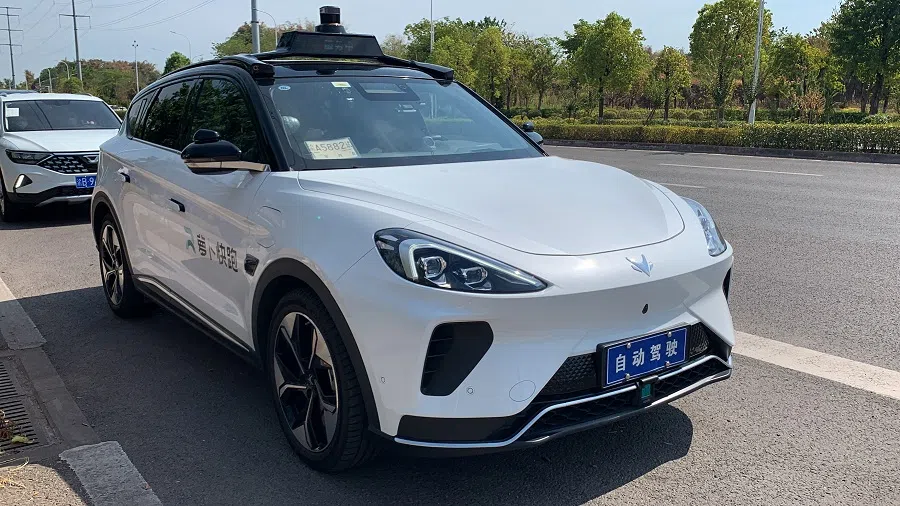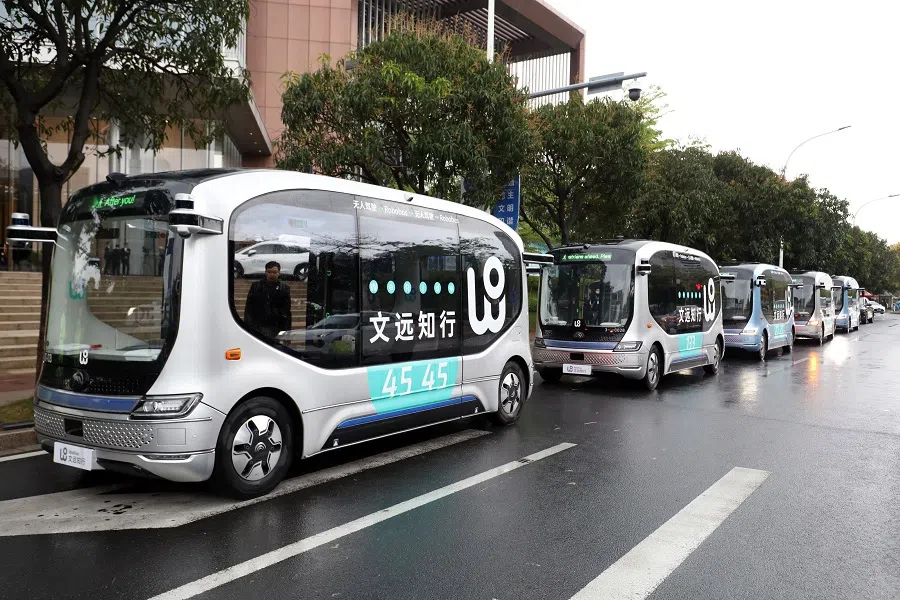Three students killed in EV crash: Are China’s self-driving cars safe enough?
A key reason why technologies such as autonomous driving, drones and new energy vehicles have thrived in China is the lower entry barriers and relatively relaxed regulatory requirements. However, this has also brought increasing safety risks, says Lianhe Zaobao senior correspondent Chen Jing.

When I took a hailed ride from Shanghai Pudong Airport two weeks ago, it felt like I was sitting in a trial against autonomous driving.
My driver did not hold back during the two-hour ride, talking about everything from autonomous vehicle technology company Pony.ai to Baidu’s Apollo Go robotaxi, from Shanghai to Shenzhen and Wuhan, arguing on various levels that intelligent driving is, in fact, not intelligent, and autonomous vehicles may not benefit humanity.
Fatal accident in an autonomous vehicle
As we spoke, a stretch of roadworks appeared ahead. The car in front of us was caught off guard and suddenly slammed on the brakes. My driver quickly swerved around it and immediately used the incident to reinforce his point: “Did you see that? In sudden situations like this, experienced drivers like us know how to take evasive action. But does intelligent driving know what to do?”
The driver’s words were prophetic. A few days later, Xiaomi — a rising star in the smart electric vehicle world — was involved in a fatal accident suspected to have been caused by its autonomous driving system.
On the night of 29 March, a Xiaomi SU7 electric vehicle caught fire after crashing into a cement barrier on a highway in Tongling, Anhui. All three female university students in the car died. Following the incident, the victims’ families raised concerns about potential vehicle malfunction, spontaneous combustion and locked doors, calling for a response from Xiaomi.
On 1 April, Xiaomi said that the vehicle was in NOA (Navigate on Autopilot, an intelligent assisted driving mode) before the crash, travelling at 116 km/h. The section of the road where the accident occurred was under maintenance, with roadblocks closing off the original lane. After detecting the obstacle, the vehicle issued a warning and began to decelerate. Although the driver took over control, the car still collided with the cement barrier.
... the AEB [Automatic Emergency Braking] system does not respond to common obstacles such as traffic cones, water barriers, rocks or animals.

Many questions surrounding the accident remain unanswered, with the most contentious issue being the role of autonomous driving. According to data from the vehicle’s backend system, only two to four seconds elapsed between the NOA system warning and the collision with the cement barrier — barely enough time for the driver to react. Why was the alert from the intelligent driving system delayed? Why was the Automatic Emergency Braking (AEB) system not activated?
At the SU7 launch event a year ago, Xiaomi founder Lei Jun claimed that the AEB system could recognise stationary vehicles ahead and automatically stop the car at speeds of up to 135 km/h during the day and 120 km/h at night on highways. However, many SU7 owners only learned through Xiaomi’s statement after the accident that the AEB system does not respond to common obstacles such as traffic cones, water barriers, rocks or animals.
Just a week before the Xiaomi car accident, another incident came to light involving a new energy vehicle — the Aito M7, co-developed by Chinese tech giant Huawei and automaker Seres. The vehicle owner claimed to have once won the Huawei Intelligent Driving Masters Competition. In late December last year, while using the intelligent navigation assist feature at 120 km/h, the car rear-ended a stationary concrete pump truck; the vehicle was totalled, and the driver hospitalised.
... automakers often emphasise terms like “autonomous driving” and “zero intervention” in their marketing, misleading drivers to believe that intelligent driving equals full self-driving.
Not yet fully autonomous
Analysts have pointed out that the intelligent driving technology in most new energy vehicles is still not mature. However, automakers often emphasise terms like “autonomous driving” and “zero intervention” in their marketing, misleading drivers to believe that intelligent driving equals full self-driving.
In reality, according to the official autonomous driving classification system, only vehicles reaching Level 5 — where no human input is required at all — qualify as fully autonomous. The NOA system in the Xiaomi SU7 is only at Level 2, which still requires the driver to remain fully attentive and in control.

Beyond the automakers’ overselling, another reason for the rapid adoption of intelligent driving in China is the high level of trust drivers place in these features. Beijing’s new autonomous driving regulations, which kicked in on 1 April, support the use of self-driving technology in public transportation and taxi services. Robotaxi services such as Baidu’s Apollo Go have already launched in over ten mainland Chinese cities including Beijing, Shanghai and Guangzhou, and road testing has also started in Hong Kong.
In contrast, Singapore began testing autonomous vehicles a decade ago but despite its ambition to become a “Smart Nation”, it has yet to roll these vehicles out on a large scale due to the government’s stringent control over technology testing.
Two years ago, I interviewed a Singaporean entrepreneur developing robots in China, who had spent many years as a researcher at a Singapore university. He candidly remarked that in Singapore, every step of R&D must be done to perfection before it can move forward, “but in the Chinese market, you can launch at 80%, then seek to improve afterwards”.
The ride-hailing driver I met also said that he looked forward to an autonomous driving system that can take orders and help him earn money while he rests at night. “But if it’s going to steal my rice bowl, I’ll be the first to object,” he added.
Safety risks and social impact
Lower entry barriers and relatively relaxed regulatory requirements have allowed more cutting-edge technologies to be quickly implemented and widely applied in China, accelerating further iterations and upgrades. This is one of the key reasons why technologies such as drones and new energy vehicles have thrived in China in recent years. However, this has also brought increasing safety risks, while its social impact also cannot be ignored.

Last month, Associate Professor Li Mingjiang from the S. Rajaratnam School of International Studies at Nanyang Technological University cautioned at a public forum that while artificial intelligence enhances work efficiency, it will inevitably cause widespread job losses, posing challenges to employment and public policy. Countries with more robust welfare systems are better equipped to handle such shifts, but China lags far behind many countries in terms of social security and welfare, so its people will feel a greater impact.
The ride-hailing driver I met also said that he looked forward to an autonomous driving system that can take orders and help him earn money while he rests at night. “But if it’s going to steal my rice bowl, I’ll be the first to object,” he added.
Amid the escalating China-US tech rivalry, China’s resolve to advance its technology will not waver, and the development of intelligent driving will not stop because of a few accidents. Still, these macabre incidents serve as a sobering reminder to this fast-charging industry: perhaps it is time to ease off the accelerator — at least long enough to address the safety hazards brought by technology — and reconcile the clash between innovation and people’s livelihoods.
This article was first published in Lianhe Zaobao as “智能驾驶该减速了?”.



![[Big read] China’s 10 trillion RMB debt clean-up falls short](https://cassette.sphdigital.com.sg/image/thinkchina/d08cfc72b13782693c25f2fcbf886fa7673723efca260881e7086211b082e66c)
![[Big read] Love is hard to find for millions of rural Chinese men](https://cassette.sphdigital.com.sg/image/thinkchina/16fb62fbcf055b710e38d7679f82264ad682ce8b45542008afeb14d369a94399)
